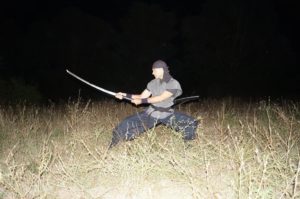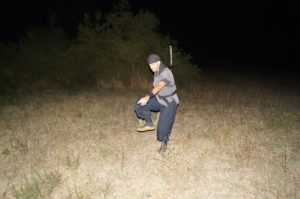Fifty eight kilometres in 12 hours were walked by the participants in the seminar The Path of Shugenja, which was held yesterday.
On „The Final Journey“, 13 members from Bujinkan Macedonia and two guests were participating. Unfortunately, halfway of the predicted route, one of them had to quit because of health problems, caused by the great strain.
The seminar started at 08.00 hours, when after short preparations, the group directed herself to the slopes of Lipac. After hour of climbing, Beljakovski Monastery was reached, and then the participants continued south, to Pezovo. On the halfway to the village, one of the participants of the seminar started to experience health problems, after what shidoshi Dovezenski had to decrease the movement speed. With a turn to south-east, the group headed to the village Tatomir, where the frail one was sent by a car to Skopje. Because of the unplanned detour, a slight change was made to the plan, so instead of of the finishing point to be Skala, the group made a circle arc to the north walking around the west part of Sekulica. With the gradual decrease of elevation, the participants got down to the bed of River Kriva Reka in the village Shopsko Rudare. Moving to the west, through Konjuh, they entered the village Beljakovce. Five kilometres until the starting point, in honor of The Final Journey, the members of Bujinkan Macedonia did fifty push-ups with full gear on, and then walked the last kilometres. After reaching the starting point of the route, shidoshi Dovezenski announced this seven-year feat as closed.
The calculations that were made with the help of army maps and satellite navigation, showed that in 12 hours sharp, 58 kilometres were walked in hill, mountain and difficult to pass terrain.

 Ninjutsu
Ninjutsu Нинџутсу е стара јапонска боречка вештина која до денешен ден останала покриена со превезот на мистеријата, така што таа е малку позната дури и за јапонскиот народ. Во средновековна Јапонија, во време кога таа била поделена меѓу десетина воени заповедници (даимојо-а), често доаѓало до судир меѓу нивните војски предводени од самурајските воини. За самураите било голема чест да се загине во време на војна, бидејќи така им налагал нивниот кодекс. Од друга страна, кодексот на буши (воините) не важел за нинџите. Тие употребувале посебен неконвенционален начин на борба. За нив единствено било важно како да се изврши задачата, да се заштити своето семејство и да се преживее. Тоа бил нивниот кодекс.
Нинџутсу е стара јапонска боречка вештина која до денешен ден останала покриена со превезот на мистеријата, така што таа е малку позната дури и за јапонскиот народ. Во средновековна Јапонија, во време кога таа била поделена меѓу десетина воени заповедници (даимојо-а), често доаѓало до судир меѓу нивните војски предводени од самурајските воини. За самураите било голема чест да се загине во време на војна, бидејќи така им налагал нивниот кодекс. Од друга страна, кодексот на буши (воините) не важел за нинџите. Тие употребувале посебен неконвенционален начин на борба. За нив единствено било важно како да се изврши задачата, да се заштити своето семејство и да се преживее. Тоа бил нивниот кодекс.
 посилни и повешти, но истовремено ги развиваме искреноста, чесноста, сочуството и достоинството. Меѓутоа, мора да признаеме дека тоа не се постигнува лесно и преку ноќ. Совладувањето на патот кој не води до таа цел е тежок и е посипан со боцки. Но сепак, тие кои ќе успеат да го поминат, добиваат чуство на внатрешен мир, самодоверба, совршена контрола над сопственото тело, позитивен став и радост кон животот.
посилни и повешти, но истовремено ги развиваме искреноста, чесноста, сочуството и достоинството. Меѓутоа, мора да признаеме дека тоа не се постигнува лесно и преку ноќ. Совладувањето на патот кој не води до таа цел е тежок и е посипан со боцки. Но сепак, тие кои ќе успеат да го поминат, добиваат чуство на внатрешен мир, самодоверба, совршена контрола над сопственото тело, позитивен став и радост кон животот.